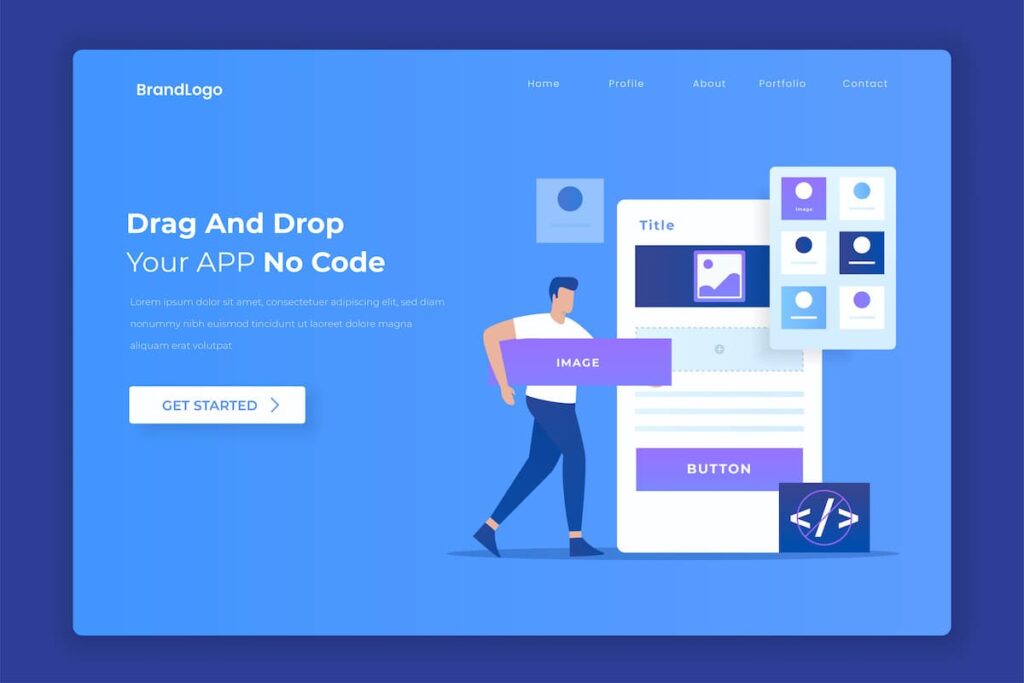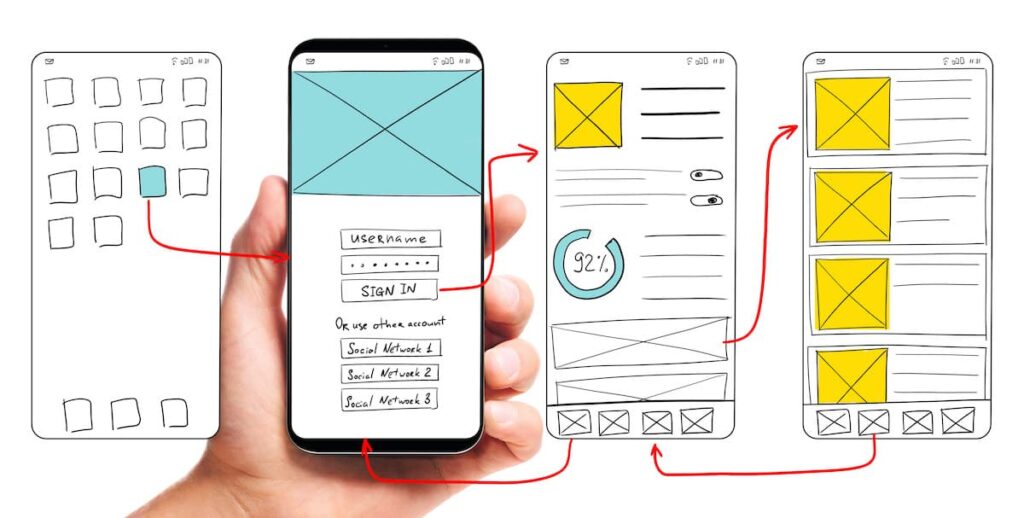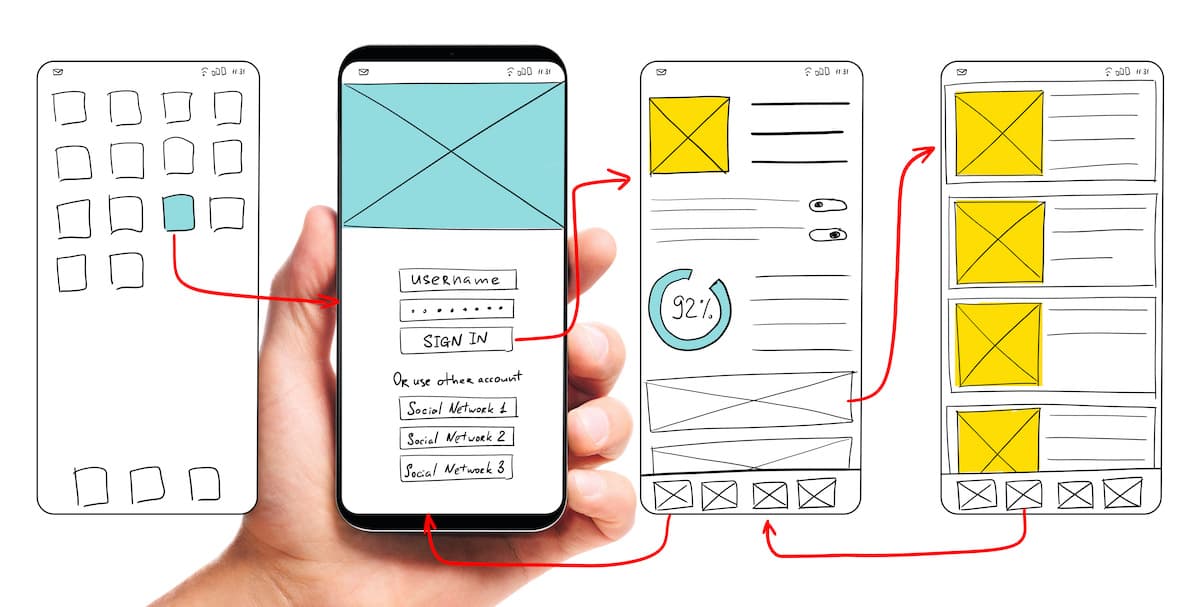Low code no code movement is on fire right now. You can ask why? The answer is simple – the way developers build simple things is changing faster than you think. We assume that this hype is the real deal and soon there will be another branch of employees on board at different IT companies around the world who will specialise in just that.
The low code no code movement is just beginning to get more attention, but we have closely observed its development over the years. In the following article, we are sharing all of the details you need to know about this topic. Grab a cup of coffee or tea and read more below.
Low code no code movement – what is that?
Low code no code movement is an approach to software development that reduces (or sometimes completely eliminates) the amount of custom coding required to build an application.
This can be achieved with low code no code development platforms which incorporate drag-and-drop interfaces and reusable code templates into the software development process.
Read more: The right questions to ask before you start outsourcing software development ➜
Low code or no code – what is the difference?
When it comes to low code and no code, there is a major difference.
Low code development simplifies the development process for non-developers and offers greater flexibility, but it does not eliminate the need for coding skills entirely. The ability to code is essential in this process in order to fully implement the application’s functionalities.
This need is eliminated altogether in the no code approach where the application development is limited to a drag-and-drop process. That being said, as no code development relies on pre-built editing capabilities, the features that can be built into an application are constrained.
The vast appliance of no code development
No code tools go beyond choosing from building blocks and creating the end-product with them. In fact, some of these tools don’t even contain blocks to grab and drop in the first place. Usually, these tools are dedicated to creating particular software applications and impose certain ready-made solutions and allow you to adapt them to your situation.
Read more: Start your new digital project with our help ➜
Therefore, low code no code development tools and platforms can be utilized in creating digital solutions for various business and technical purposes (that of course if complex customization and functionality are not required). Low code no code can be used for creating:
- landing pages
- back office apps
- databases
- mobile apps
- automation of business processes
- e-commerce solutions
- gaming (a good example here is Roblox)
- SaaS platforms (e.g. Sharetribe)
- software testing (e.g. bugbug.io)

Tools for low code no code movement
As the popularity of the low code no code movement is on the rise, we can expect more and more tools to launch in the near future. Nevertheless, there are already many useful tools that can be used. Let’s have a look at some of the most popular ones:
WordPress
WordPress is one of the most well-known CMSs and no code tools for creating media-based websites out there.
Webflow
Webflow is another example of no code solutions for building websites. However, unlike WordPress, it offers full HTML, CSS & JavaScript control as well as a custom database.
Wix
The Wix website builder is a tool that lets users create, design, manage, and develop their website’s presence without having to know how to code.
OutSystems
OutSystems is a full-stack development platform that provides a fast way to build and deliver secure, scalable applications for web and mobile.
Zapier
Zapier helps businesses build automations that connect thousands of apps without having any programming knowledge to do so. As a result, they can quickly build connections between different apps, which was previously impossible without a team of developers.
Zoho Creator
Zoho Creator can be used to create simple yet flexible business applications that help with organising and automating the employees’ work (ex. handling customer requests, registrations, customer support, sales processes etc.).
Read more: Identifying the best digital investments: Use Cases ➜
Why is the movement getting more attention right now?
The number of low code no code tools has increased significantly over the past few years. It shouldn’t surprise anyone that the movement is gaining traction considering that by eliminating coding barriers, it allows almost anyone to create innovative digital solutions.
Since the ever growing demand for web and mobile applications is not forecast to slow down any time soon, tools which can be quickly learnt and used in action to address this demand are highly appreciated, even among developers.
There’s a reason for this: coding takes time. And since many applications have a lot of common components, it is sometimes necessary to code the same elements over and over again. As a result, a lot of time can be wasted. This is where the low code no code solutions come in handy.
What is more, the road to becoming an experienced developer is long and not particularly easy. This is why a growing number of people see a huge career opportunity in the low code no code movement – by mastering a certain tool, they are able to quite quickly develop digital solutions without a lot of room for error.
Read more: What front-end tests you should write for your next project in 2022 by Łukasz Błaszyński ➜
Low code no code has a great deal of benefit for entrepreneurs and businesses, too. Most importantly, they can utilize low code no code to evaluate various technical business ideas without having to spend a lot of time and money on developing them with a dedicated IT team.
Furthermore, the movement encourages entrepreneurship by making it easier for small and mid-sized businesses to build websites or other products at low cost, especially in the beginning phases when budgets are usually limited.

Pros vs cons of the low code no code movement for your company
Like anything else, the low code no code movement also has its advantages and disadvantages. It might be worthwhile to examine them fully if you plan on incorporating low code no code in your company. Below we share some of the most important ones.
9 Pros of the the low code no code movement:
1. Cost and time optimization
This is especially important for businesses which, when hiring IT personnel, must spend a large piece of their budgets. Moreover, low code no code is easier to implement and the results can be seen faster while having less space for mistakes which is often the case in real-life programming.
It is worth mentioning that the low code no code tools can be also utilized by developers themselves to make their work quicker and more efficient as by doing so, they can spend less time on coding repetitive elements.
Read more: Our tips for effective cooperation on outsourcing software development ➜
Forrester found that low code no code development helps developers make cloud-native applications more than 10-times faster (with 70% fewer resources).
2. No requirement of special developer skills (but often you still need to think like an engineer)
No previous technical background or knowledge is required to start using the no code development tools. Nevertheless, it can sometimes be helpful in the low code solutions which offer more room for customization.
3. Easier to incorporate (good and easy-to-digest online tutorials)
As low code no code tools continue to rise in popularity, so do online tutorials and manuals explaining how to effectively use them. Low code no code platforms usually have a simple structure and logic, which makes them easy to integrate and scale if necessary.
4. Utilizes visual interfaces
The movement makes it possible to create user-friendly mobile applications for customer experiences with pre-built user interface templates.
Read more: Data driven, goal-oriented product design ➜
5. Automated application lifecycle management
One of the benefits of low code no code is that it consolidates several stages of the software development lifecycle (e.g debugging, testing or deployment). Thanks to this, it is also possible to revert the app to previous versions if needed for better application lifecycle management.
With no code low code, you don’t need to hire a team of experts as the majority of software development tasks can be handled by one person.
6. “Out of the box functionality”
When you run a project with no code or low code, you have a well-defined set of features available to use right away. You don’t need to configure dependencies or assemble your technology stack.
No difficult decisions about which architecture layers to use are necessary. Things simply work immediately after you use them.
7. The decentralization of responsibility
With the movement, it is possible to delegate responsibilities for various areas (such as architecture, build management, database etc.) to an external provider that is an expert in this area. For instance, Webflow CMS offers hosting without the hassle of setting up databases, storage etc.
8. Easier prioritizing
If something is difficult to build with your no code, it often indicates that it is a less common need – maybe your users don’t need it? For example, you cannot easily add social sharing links in Webflow CMS but you can with custom code. However, do users actually use them?
9. Security
Additional advantage of low code no code is that the responsibility for keeping the tool secure is delegated to the provider.
7 Cons of the low code no code movement
1. Limitations and lack of total uniqueness
As low code and no code tools are essentially just tools with limited functionality and customization possibilities, they can restrict you in terms of what exactly you can build. Nevertheless, this depends on the platform of your choosing so make sure to do a thorough research beforehand.
2. Vendor lock-in
Something to consider before implementing low code no code tools is that one can find yourself in a vendor lock-in. This refers to a situation where the cost of switching vendors is so high that customers are forced to remain with their original provider.
Read more: Data driven, goal-oriented product design ➜
How can this happen you might ask? There are at least a couple of ways. Not all tools offer an export capability. Even if you can export, some providers can use code that is difficult to maintain outside of their platforms. Additionally, your app might no longer be editable once you stop using certain tools.
Therefore, knowing each vendor’s export options and licensing policies is essential before purchasing a low code no code tool.
3. Lack of portability
Lack of portability might not be a major issue since most business processes and sites will be designed anyway every 3-4 years. Some low code systems like Outsystems are fully portable.
4. Security risks
Sometimes the security of the more popular tools can be compromised. Consequently, as the development process is faster it is also less structured. Because of this, if these technologies are handled by individuals without security training, risk can be introduced.
Furthermore, in the case of a hacker attack, it would be relatively easy to gain access to all solutions created with it, and the creators cannot protect themselves from that.
5. The need to pay extra for add-ons
If you wish to incorporate a low code no code tool in your organisation, you will most likely have to purchase a licence for it. Additionally, it might be necessary to pay additional fees to get premium elements in forms of add-ons etc.
6. Repetitiveness
Widgets are limited in different areas and in terms of use. Thus, this might lead to building a digital product which will be similar to other products on the market which were built using the same low code no code tool.
Read more: How to scale your tech company for the win ➜
7. Limited system integration
Low code no code platforms might impose some limitations to the possible system integrations. Hence, depending on the business needs, it is crucial to check the full functionality of the particular tool before incorporating it into the workflow.
This is not always a limitation, built in integrations are easy to use so that the back end data is more widely utilized and provides more value for the organization.

Low code no code at Espeo Software. How are we utilizing its possibilities on a daily basis?
We at Espeo leverage low code no code ourselves in a variety of ways including UX, marketing and software development.
No code in UX design
We provide our clients with advanced prototypes which we create in a no code tool called Webflow. It allows us to quite quickly build realistic simulations which help our clients validate the user experience of their apps.
Examples of our work:
- Caring for premature babies and infants who require special attention: mobile app for a daily development navigation
- Awake.AI case study
- Product Design Workshop materials to download
No code in Marketing
Our internal marketing team utilizes a number of low code no code tools for marketing automation and day to day tasks. Hubspot and Elementor are two great examples of such utensils.
No code in software delivery
Sometimes, low code no code helps us speed up the work on certain projects. Thanks to combining the usability of no-code tools with high-quality custom code, we are able to provide our clients with top-notch solutions within a short time.
Read more: Espeo Software Wins Clutch Award for Poland’s Finest Developers ➜
For instance, for our pro bono project for Laboratorium Marzeń Foundation, we plan to use a pre-built CMS admin panel which allows API integration.
This way, we will be able to solely focus on the frontend and backend part of the app.
Will the no code movement replace programmers?
The short answer is: no. No matter how significant the low code no code movement becomes, there will always be a need for the integration of systems, the implementation of more specific and advanced solutions, or the creation of new algorithms. Needless to say, at the end of the day developers are needed to build the low code no code platforms in the first place.
Read more: Espeo Blockchain receives the exclusive Hyperledger service provider certification ➜
However, many businesses will incorporate no code tools into their operations in order to save money and hire fewer developers. The low code no code movement is also a great opportunity for start up companies as it allows them to quickly build a working solution, especially at the MVP level, when it is important to reach the first customers with it.
Read more: How to organise a successful digital workshop ➜
Most of the time, with no code platforms, they can effortlessly introduce immediate changes to the solution, without the need to involve (or even hire) dedicated IT professionals. When it comes to established enterprises and corporations, as they have bigger budgets to allocate, they will continue to hire experienced developers with advanced coding skills. Especially in cases when extensive application functionality, data governance and deployment to specific architectures or environments are required.
Low code no code movement in 2022 – what will the future bring
Low code no code is growing rapidly. As it carries on solving real business problems, the movement will continue to gain traction, especially in the light of the shortage of developers.
According to Gartner analysts, the low code market is expected to surpass $13.8 billion by the end of 2021 and to continue to make gains until it reaches nearly $30 billion by 2025. Furthermore, Gartner forecasts that by 2024, low code application development will represent 65% of all application development activity, primarily for small and medium-sized companies. Another leading global market research company, Forrester, predicts that, by the end of 2021, 75% of all software agencies will adopt low code platforms.
Read more: Industries that grow faster amid the pandemic with the help of digitalisation ➜
Meanwhile, KPMG research indicates that the number of business executives who deemed low code no code development platforms as their main automation investment has almost tripled since the start of the pandemic in early 2020.

A large part of the growing interest in this movement is also due to the fact that it removes the barriers that once existed by opening up the world of software creation to those who may be intimidated by learning how to code. Vlad Magdalin, the founder and CEO of Webflow, has recently said in an interview with TechRepublic: “The low code no code movement is democratizing the act of software creation the same way that YouTube democratized video creation.”
As a result, a new type of non-IT professionals is emerging. So-called citizen developers, as Gartner referred to them as early as in 2012, are employees who build application capabilities that can be consumed by themselves or others, using tools that aren’t restricted by IT or business. In a report titled “Future of Applications: Delivering the Composable Enterprise”, analysts at Gartner predicted that by 2023 there will be at least four times more citizen developers working at large enterprises than professional developers.
Read more: Project Management Checklist: Before You Start ➜
As McKinsey demonstrated in a recent report, organizations that empower citizen developers outperform those that do not on innovation measures. In light of this, the demand for nontechnical experts will only increase in the future.
Our expert’s opinion on the low code no code future
Dominik Zyskowski, Consulting Director at Espeo Software, provided us with his insight into the future of the low code no code movement. In the testimonial he shared especially for the sake of this article, he says:
“There is no question that no code will continue to gain popularity as the number of people realizing that they do not have to learn coding to develop tech solutions is on a rise.
It is mainly possible because more and more people are exposed to a wide variety of technologies from childhood, which makes it easier for them to internalize new digital solutions and navigate systems for building apps. Nowadays, even kids can learn how to develop games using tools such as Scratch.
Though the demand for custom software development will never diminish, more and more solutions will be able to be developed with low code no code tools.”






